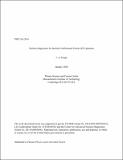| dc.description.abstract | The field of nuclear diagnostics for Inertial Confinement Fusion (ICF) is broadly reviewed from its beginning in the seventies to present day. During this time, the sophistication of the ICF facilities and the suite of nuclear diagnostics have substantially evolved, generally a consequence of the efforts and experience gained on previous facilities. As the fusion yields have increased several orders of magnitude during these years, the quality of the nuclear-fusion-product measurements has improved significantly, facilitating an increased level of understanding about the physics governing the nuclear phase of an ICF implosion. The field of ICF has now entered an era where the fusion yields are high enough for nuclear measurements to provide spatial, temporal and spectral information, which have proven indispensable to understanding the performance of an ICF implosion. At the same time, the requirements on the nuclear diagnostics have also become more stringent. To put these measurements into context, this review starts by providing some historical remarks about the field of ICF and the role of nuclear diagnostics, followed by a brief overview of the basic physics that characterize the nuclear phase and performance of an ICF implosion. A technical discussion is subsequently presented of the neutron, gamma-ray, charged-particle and radiochemistry diagnostics that are, or have been, routinely used in the field of ICF. This discussion is followed by an elaboration of the current view of the next-generation nuclear diagnostics. Since the seventies, the overall progress made in the areas of nuclear diagnostics and scientific understanding of an ICF implosion has been enormous, and with the implementation of new high-fusion-yield facilities world-wide, the next-generation nuclear diagnostics will play an even more important role for decades to come. | |
